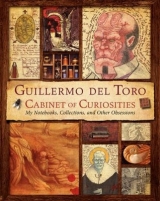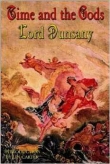
Текст книги "Cabinet of Curiosities: My Notebooks, Collections, and Other Obsessions"
Автор книги: Guillermo del Toro
Соавторы: Marc Scott Zicree
Жанры:
Публицистика
,сообщить о нарушении
Текущая страница: 2 (всего у книги 17 страниц)
AT HOME
As I approached Bleak House for the first time, a house with an oddly Gothic air located in a subdivision outside of Los Angeles, I couldn’t help thinking of the opening lines to one of Edgar Allan Poe’s short stories:
During the whole of a dull, dark, and soundless day in the autumn of the year, when the clouds hung oppressively low in the heavens, I had been passing alone, on horseback, through a singularly dreary tract of country; and at length found myself, as the shades of the evening drew on, within view of the melancholy House of Usher.
I had come to Bleak House to begin the series of conversations that would form the foundation of this book. The sky was slate and intermittently rainy, and as I drew near the door, the rambling edifice towered over me, the storm clouds sweeping across the dragon weather vane like a leprous hand.
I regarded the heavy iron knocker like Marley’s ghost, raised it, and struck three times. A moment later, the thick oak door swung wide. There stood Guillermo.

The name plate that adorns the exterior of Bleak House.
“Come in, come in.” His big hand waved me inside.
Across the threshold, I found myself in a realm of wonders. In the foyer was what appeared to be an enormous figure of Sammael, the outrageous demon from Hellboy. To my left was apparently an antique oil of Saint George killing the dragon, to my right busts of Uncle Creepy and Cousin Eerie. Gleaming wood detailing flanked walls incarnadined as if infected by the mysterious plague from Poe’s “The Masque of the Red Death.” There was a life-size figure of the pinhead from Freaks and of Karloff’s Frankenstein, plus samurai armor, automata old and new, and the skulls and skeletons of creatures real and imagined. And in every square inch, filling room upon room, were framed insects and original art by Arthur Rackham, Bernie Wrightson, Edward Gorey, Drew Struzan, and Basil Gogos, along with first editions of Twain, Dickens, L. Frank Baum, and Andrew Lang, plus rare treatises on magic, the occult, and vampirism, on the monstrous and the dream-born.
It is a collection Guillermo describes as “every book I ever read and most every toy I ever bought,” all of it as meticulously designed as a Tiffany egg. Bleak House is Xanadu, if Charles Foster Kane had been thirteen years old and the most brilliant geek ever.
“The fact is,” Guillermo says, “that what I do is not fan art. My films are not fan films, even if I am immersed in pop culture. That is just one facet of what I do, what I draw upon, and who I am. I am influenced by literature as much as I am by comics, and by fine art as much as I am by so-called low-brow. But I am not trapped by either extreme. I transit between these parameters in absolute freedom, doing my own thing. I try to present myself as I am, without apologies and with absolute passion and sincerity. I study my subjects and plan my work meticulously. Think of Cronos, Devil’s Backbone, or Pan’s Labyrinth and you will see that what I do is not only to recontextualize artistic forms but reflect on the genres or subgenres that they belong to. I try to deconstruct through love, through appreciation, not by referencing, but by reconnecting the material with its thematic roots in a new approach. The vampire film, the ghost story, and the fairy tale are re-elaborated in my work, rather than just reenacted or imitated. I never want to follow a recipe; I want to cook my own.”
As for Guillermo, he likes to call it his “man cave.”

Bleak House is a mixture of predominantly Victorian and Gothic elements by way of Hollywood, with real and imaginary skeletons scattered throughout.

An alcove at Bleak House devoted to Charles Dickens.
I’ve had this feeling three times before in my life.
When I was seven, I visited the Ackermansion, Forrest J Ackerman’s stupendous collection of monster and sci-fi memorabilia. Uncle Forry’s home was filled with articulated dinosaurs from King Kong, the latex alien hand from The Thing, Spock’s pointed ears, original art by Frank R. Paul and Virgil Finlay, a copy of the robot from Metropolis, and thousands of other items. The second time was when I was in my early twenties and literally crawling through Rod Serling’s attic while researching my book The Twilight Zone Companion. The attic housed heavy leather volumes holding every article and snippet printed about Serling, files with notions finished and unfinished, a box full of unproduced Twilight Zone scripts, and plastic airplane models still in their boxes. The third time was when I visited Ray Bradbury’s canary-yellow house in Cheviot Hills, which overflowed with mementos and touchstones from his miraculous life. From original Joe Mugnaini artwork for Fahrenheit 451 and The Martian Chronicles to the toy typewriter he’d first started writing on at age twelve, everywhere there was wonder.
“Never throw out anything you love,” Ray said on many occasions. In each of these homes, a brilliant man’s head and heart had seemingly exploded to fill a house, inviting visitors to scrutinize, linger, and be nourished. But Guillermo’s house, by dint of sheer passion and obsession, tops them all.
Guillermo charmingly refers to Bleak House as his “collection of strange crap.” In a more serious mood, he adds, “You’re God as an artist, and it’s really just the way you arrange. I think a director is an arranger. I direct this house, and everything goes somewhere, and I can tell you why, and there are thematic pairings, or there is a wall with all blue on it. There is nothing accidental. And my movies are like my house. I hang every painting, and if the frame shows a clock or a watch, or shows an apple, or shows a piece of furniture, I chose that, and I ask the art director and the production designer to show it to me before, and I walk the set and I say, ‘Take this out’ or ‘Bring this in.’ It really is the beauty of the director, I think, in the way I understand the craft.”
On that first visit, Guillermo led me deeper into the house. I was agog at the cinematic, literary, artistic, and zoological feast—akin to the food piled high to tempt Ofelia at the Pale Man’s table in Pan’s Labyrinth. Wandering Bleak House is a Through the Looking-Glass experience, as if one has actually stepped into one of Guillermo’s films.
Through glass doors leading to the backyard, I spied the life-size bronze of Ray Harryhausen, one of Guillermo’s spiritual godfathers. Then we turned down a hallway lined with wild art, gleaming weird mechanisms—some insectile, others mechanical—tin toys, Pez dispensers, anatomical models, and a miniature of the Time Machine from the eponymous 1960 film by George Pal, another member of Guillermo’s pantheon. Hovering as if in benediction, now tied permanently to a wall as he’d once been strapped to Ron Perlman’s back in Hellboy, was the torso and head of the Russian corpse, a role voiced in the movie by Guillermo himself. Just off the hall were the How to Look at Art volumes that started it all, and at the end of the corridor, in a glass case, was the first Pirates of the Caribbean model Guillermo so lovingly assembled and painted as a child.
And then the pièce de résistance. Like a character out of Poe or Dickens, Arthur Machen or M. R. James, or any of the legion of outré writers of whom Guillermo is an acolyte, my host beckoned me to enter his sanctum sanctorum, the room where Guillermo writes his scripts at a big old wood desk or, more often, on the overstuffed leather sofa. Best of all, at the flick of a switch, lightning flashed, thunder rumbled, and rain cascaded down false windows looking onto endless night.
We settled into the leather sofa and began to talk.
A LIFE FULL OF WONDER
In fashioning his house, Guillermo credits Forrest J Ackerman as a key inspiration, but there is another guiding principle that predates Ackerman and gives a deeper meaning to Bleak House.
Call it Guillermo del Toro’s cabinet of curiosities.
After all, everything surrounding this fabulous, larger-than-life character, from his films to his house to his notebooks to his speaking engagements, is chock-full of extravagant, peculiar, and extraordinary items—his world is an overflowing credenza of marvelous things. Further, the term’s provenance makes it particularly fitting.
Originally, cabinet of curiosities referred to a personal collection of spectacular, eclectic, and outlandish objects accumulated by a wealthy person, often an aristocrat. Also known in German as wunderkammer (“wonder room”) and kunstkammer (“art room”), these “cabinets” were not pieces of furniture but entire rooms full to bursting with every unusual and attractive bauble that could be found in the natural world or realms constructed by humanity. Hitting their peak of popularity in the seventeenth century and spurred by the discovery of the New World, these cabinets might house clockwork automata, Chinese porcelain, the crown of Montezuma, a madonna made of feathers, chains of monkey teeth, a rhinoceros horn and tail, conjoined twins, a mermaid’s hand, a dragon’s egg, real or supposed holy relics, vials of blood that had rained from the sky, an elephant head with tusks, carved indigenous canoes, an entire crocodile hanging from the ceiling, a two-headed cat, and as one list concluded, “anything that is strange.”
At the time, science had not yet developed standardized methods of classification, and museums had not yet been established for public consumption, so these cabinets of curiosities grew at the whims of their owners in bizarre and breathtaking ways, each its own deformed, magnificent, unique universe.
Sporting titles redolent of their times, those famous for their cabinets included the Holy Roman Emperor Rudolf II, Archduke of Austria Ferdinand II, Peter the Great, Augustus II the Strong, King Gustavus Adolphus of Sweden, John Tradescant the elder, Elias Ashmole, and the deliciously named Ole Worm.
In some fascinating way, these wild, untamed accretions were autobiographies of their owners, spotlights playing over the darkest corners of their minds, Dorian Gray portraits they could display without ever admitting that these collections revealed true images of themselves.
Francesca Fiorani wrote in Renaissance Quarterly, “The Kunstkammer was regarded as a microcosm or theater of the world, and a memory theater. The Kunstkammer conveyed symbolically the patron’s control of the world through its indoor, microscopic reproduction.”
In a modern context, what better possible description could you have for a motion picture?
Without a doubt, Bleak House is Guillermo del Toro’s great cabinet of curiosities, deliberately so. It is a microscopic reproduction of the world seen through his own lens. But it is not his only one. Guillermo has crafted an even more personal and miniaturized domain.
At the beginning of his cinematic career, Guillermo’s mentor Jaime Humberto Hermosillo insisted he keep notes. “I started with a tape recorder,” Guillermo recalls, “and I would record every idea that came to mind. I had it in my pocket. But I never transcribed those thoughts, and I lost the tapes. Then I started carrying the Mexican equivalent of the Moleskine book, and it was a very poorly put-together spiral notebook, so the leaves started to get loose. Finally, around 1986 or ’87, I bought what was then a revolutionary thing, the Day Runner. They were like eighty dollars when they first came out, and I thought they were the equivalent of a portable computer. I fell in love with the blue notepaper, and I still have sixty or seventy packets. I said, ‘I’m going to buy enough blue paper for the rest of my life.’ I started keeping notes in there, and I found it really great because it was very well put together, very sturdy. I carried it on location. It rained and it didn’t get wet. It was fantastic. So that was the beginning of the notebooks.”

Frans Francken the Younger’s Chamber of Art and Antiquities (1636), a painting depicting a seventeenth-century cabinet of curiosities made up of art, collectibles, and oddities from the natural world.
Initially, Guillermo jotted down notes and illustrations mainly for himself and for those he was working with. “Usually those notebooks were used only to communicate with actors or designers, to show them the world.”
With the birth of his first daughter, Mariana, Guillermo began to rethink the notebooks as mementos to leave his daughter—as something that might interest and entertain her in the future. “I gave myself the luxury of buying inks and pens, and I thought, ‘I’m going to make it an art project that she will find fun to look at.’ So I changed my handwriting, did the elongated Ts and elongated Ls to give it an old-fashioned feel, bought a quill. I wanted to make it fun for her, like finding letters. So every note that is there is not to myself, but to her.”
With the birth of his second daughter, Marisa, this determination only strengthened. “I instructed in my will that those notebooks are for them. They can quarter them, sell them, keep them, frame them, throw them out, burn them, whatever they want to do. But what they will have is a testament to curiosity. I think they indicate, not how much I know, but how much I want to know, how much I was thinking about this or that.”
He also built a conscious whimsicality into them. “What I love is the idea that the deepest stuff in these notebooks is the stuff that looks the quaintest, and the stuff that looks the deepest is the stuff that is much more playful and crazy and not necessarily meaningful.”
In designing the notebooks, Guillermo was intent on rendering flaws into the weave, deliberate stains and blemishes. “In the end,” he says, “perfection is just a concept—an impossibility we use to torture ourselves and that contradicts nature. We pursue it—God knows we have to, as artists—but ultimately, like [Friedensreich] Hundertwasser says: A straight line is pure tyranny. In art, as in life, the love of imperfection is the perfect love.”
More than valuable objects, mementos, or artworks, the notebooks possess an almost magical significance for Guillermo, who explains, “It’s really important in our life to have talismans. Everybody has one or two or three. In my case, I have dozens. You have to imbue things that surround you with power.”
In this way, one of the notebooks played a direct role in perhaps the most important juncture of Guillermo’s career. “I lost the notebook at the end of shooting Hellboy, right before Pan’s Labyrinth. It was a very important moment because I was considering doing a big superhero movie. Avi Arad [then head of Marvel Studios] had seen pieces of Hellboy and had liked Blade II, and he offered me Fantastic Four. It was a big, big, big movie for me. And I was thinking, ‘Do I do Pan’s Labyrinth, or do I do Fantastic Four?’ And I was in London, and I left the notebook in a cab.
“I always say everything that happens is a ciphered message. Like Freud said, ‘There’s nothing accidental.’ And I was thinking, Why did I lose the notebook? I spent all night meditating—I do transcendental meditation now and then—and I cried a lot. I really cried and cried and cried because these books are for my kids; I want my kids to have something from their father.
“And finally I said, ‘I get it. It’s because I was about to lose myself. I’m going to do Pan’s Labyrinth.’ And at that moment, the phone rings, and it’s the cab driver bringing it back to the hotel. I had given him an address for a comic book shop in London, and he had seen the logo of the hotel on the piece of paper, and he remembered.”
Guillermo continues to draw and write in the notebooks, and in truth, he does so for both his daughters and himself. “When I start a screenplay or a movie, a shoot, I carry all of them with me, and I browse through them because it’s like having a dialogue with a younger me. I see the stuff that was important to me at twenty-nine or thirty. I view them with great curiosity. ‘Oh, this kid was interested in this; this kid was interested in that. That’s funny.’ And ideas will spark that you wouldn’t have had before. At the end of one notebook, I made a list of what I was going to achieve in the next five years of my life. I was twenty-nine or thirty. I look back at it, and I have done all of that and more.”
While the early notebooks record an avid mind capturing impressions and developing ideas in an exuberant, spontaneous way, the later ones are increasingly self-aware, done with the knowledge that others will ultimately scrutinize them. They have been crafted with precision, each page composed as its own work of art, although images and words are now often disconnected. “I do the drawings first,” Guillermo explains. “I write around them. These things are not chronologically intact.”
The notebooks form a piece with Guillermo’s house and films, but they exhibit one key difference: With those other works of art, we see the end results brought fully to fruition, presented to us wholly formed, the edges neatly planed off. The notebooks are both process and product, expression and rumination. They are Guillermo’s creativity laid bare.
In these notebooks, we see the private man and his stance toward a public world—processing problems and working out solutions, viewing present and future with guarded optimism and counterbalanced by painful experience. On these pages, Guillermo’s projects intermingle in the most intriguing ways. Mimic, Blade II, Hellboy, The Devil’s Backbone, Hellboy II: The Golden Army, Pan’s Labyrinth, and Pacific Rim all crash into each other. They bleed together, inform one another. It’s as if the toy shop came alive when the toy maker was sleeping. The extravagant vampire design first considered for Blade II reaches full expression in The Strain, Guillermo’s trilogy of novels with Chuck Hogan; notions of clockwork mechanisms and tentacled nightmares migrate from one project to the next.

Notebook 3, Pages 48A and 48B, which include the receipt for the taxi ride in London during which del Toro lost his notebook [left], as well as the record of the police report del Toro filed [right].
Most of all, Guillermo’s notebooks present the same creative generosity one finds in the man himself. Whether he’s talking in the room where it always rains, or adding to his notebooks, or sharing his fantastic visions on-screen, he gives the gift of his whole self, and in this way makes our world a little more messy, visceral, boisterous, and exalted.
The thing about great storytellers is that they are full of great stories. Pretty much everything Guillermo says or writes is by turns fascinating, surprising, appalling, hilarious, enchanting, or moving. And like all truly great storytellers, he’s also a great soul. His stories can’t help but instruct, impart, and illuminate. In Hollywood, a dark vision is often merely a faddish pose. But you can tell when a writer-director has never seen a dead body, never spied anguish up close. With Guillermo, his heart of darkness is authentic, born of a fully lived life. He not only observes deeply but feels deeply, and he has survived to tell the tale.
“You try to make the right choices,” Guillermo notes. “I’m not a fatalist. I think that the plan, the universal plan and the universal energies, have a direction for everything. I don’t think there is a design that we can comprehend, but I think that we are all agents of destruction or construction in our lives, and one must try to make the best choices within that. When people talk about heaven and hell, I always think of Defending Your Life, the Albert Brooks movie. I think that you have a responsibility not to propagate the cancer of despair, resentment, and envy. You have the responsibility to make the right choices for the people around you and yourself. We are not going to be important, but I think the collective choices that we make are. We are going to be extinct or not by the accumulation of those choices.”

Notebook 3, opened to Pages 9A and 9B while resting on Notebook 4. Since starting his third notebook, del Toro has always used the same type of leather-bound volume, a number of which he bought from a vendor in Venice while traveling to promote Cronos.

Notebook 3, Pages 17A and 17B.
On one of the notebook pages for Pan’s Labyrinth, Guillermo has the Faun giving Ofelia a volume that reads, “The book contains every possible destiny, every possible future which your decisions could create. It was made just for you, written in your father’s blood, and will reveal its secrets to your eyes alone. Infinite and limited.”
Of this, Guillermo says, “That’s very Borges and is ‘The Garden of Forking Paths.’ Because the whole movie is about choice, and every choice gets defined when it’s made, and the choices are revealed only at that moment. So the Faun gives her a book where essentially the book tries to guide her one way or another, and she takes her own choice. This is the book that writes itself, a riff on a famous Borges story called ‘The Book of Sand,’ where every page you turn fuses with the rest and is both infinite and limited.”
Through the images in this book and the conversations with Guillermo, you’ll be given the opportunity to see the world through different eyes. There is wisdom here and heartache, exaltation, exhaustion, joy, and deep compassion.
When Guillermo began writing in the notebooks, they were for himself, then for his daughters, and now we have been invited to share in them. And at the very last, these notebooks are addressed to the boy Guillermo once was, to his past and future, a love letter of hope and of the impossible made possible. As he puts it, “If I were a kid in Mexico and I read this book, I’d be inspired.”
At this stage of his life and career, Guillermo knows full well that whatever path he chooses, it will be the journey he is meant to be on… the road he has built for himself.








